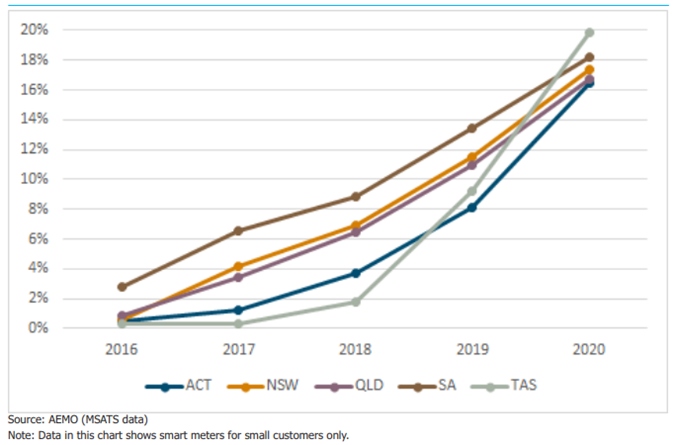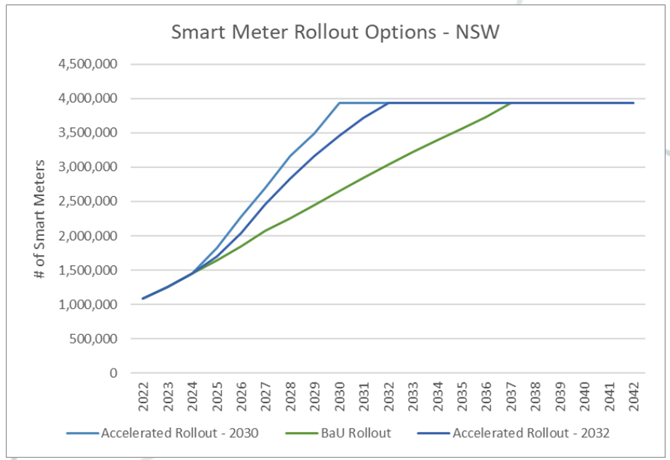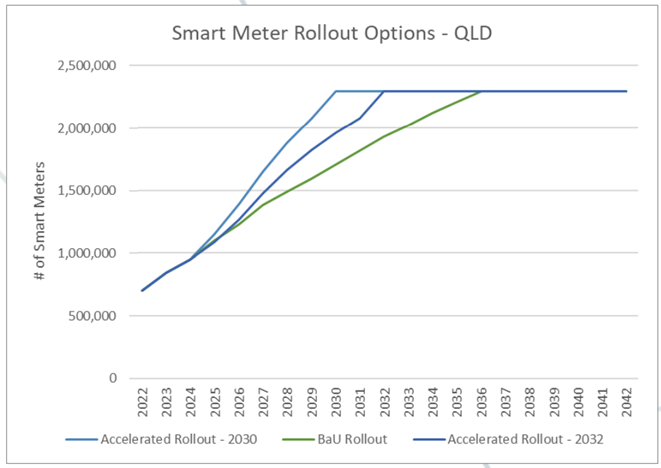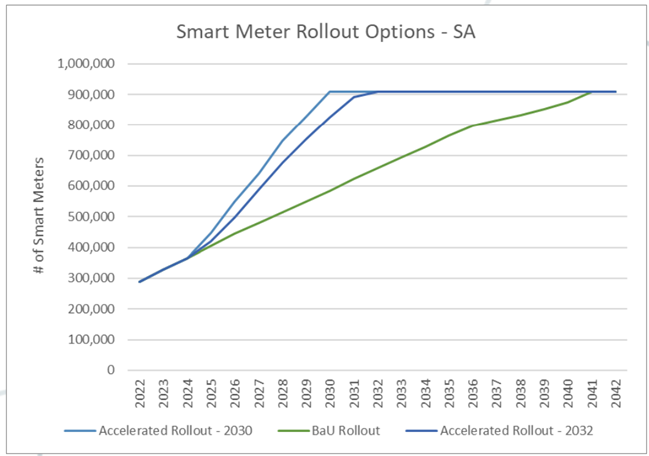Rushing to the finish line: Can we clear the hurdles on the way to 100% smart meters by 2030?
Last month, a report by the Australian Energy Market Commission (AEMC) recommended that the deployment of smart meters across the National Electricity Market (excluding Victoria[i]) should be accelerated to reach 100 per cent uptake among small customers by 2030. The AEMC argues that achieving a critical mass of smart meter deployment in a far timelier manner will deliver greater benefits for customers and support the wider decarbonisation of the energy market. In this article, we take a closer look at the reasoning within the AEMC’s final report that underpins this ambitious goal and outline some of the hurdles set for the track ahead.
Metering review for a smarter energy future
Back in December 2020, the AEMC initiated a review to determine if there were changes needed to improve both the efficiency and effectiveness of the regulatory framework for metering services. At the time, the Commission outlined that:
‘The current metering arrangements are not efficiently and effectively realising the key potential benefits that metering technology can enable for customers.’
Indeed, of particular concern to the AEMC was the steady, but slow, uptake of smart meters among small customers. As shown by the graph below, smart meter penetration had only reached 17.4 per cent across the NEM (excluding Victoria) in 2020.
Figure 1: Smart meters as a percentage of all small customer meters in each jurisdiction

Source: AEMC Consultation Paper pg.19
After a few years of extensive stakeholder consultation, the AEMC’s final report that marks the tail end of this review notes that this situation has only marginally changed. Smart meter uptake has only moved to around 30 per cent across NEM jurisdictions and should this current rate of installation continue, the Commission considers that it will ‘take another four or five years before a 50 per cent take-up rate is achieved, and a full deployment of smart meters may not occur until after 2040.’ The following graphs show the accelerated rollout options for NSW, Queensland and South Australia.
Figure 2: Oakley Greenwood graphs comparing accelerated rollout options against business-as-usual case for various jurisdictions (Tasmania excluded from analysis)
Smart Meter Rollout Options – NSW

Smart Meter Rollout Options – Qld

Smart Meter Rollout Options – SA

Source: Oakley Greenwood
This slow pace of smart meter take-up, as outlined by the report, does not meet the AEMC’s intended expectations of the current metering framework. The AEMC argues that for smart meters to deliver their intended benefits to customers and systems while underpinning the wider transition to net zero emissions, a ‘critical mass’ of meters across households and businesses needs to be achieved. Indeed, the report states that ‘the realisation of the benefits of new and innovative services is dependent upon a critical mass of smart meters,’ so that market participants can ‘justify further investments in innovative customer services.’ Likewise, a critical mass of smart meters is identified as a prerequisite to introducing other significant advances needed ‘for an orderly transition to net zero’.
The AEMC’s final report, therefore, outlines a new reform agenda that is intended to remediate the slow pace of the up take by allowing for ‘an accelerated deployment of smart meters to consumers in a timely and cost-effective way, to maximise benefits for all consumers.’ Of the options assessed during the consultation process ‘a 2030 timeframe’ for the universal uptake of smart meters was identified as the most ‘realistically achievable’.
This recommendation is supported within the report by an Oakley Greenwood cost-benefit analysis which ‘demonstrates significant economic benefits can be achieved’ by a ‘universal take up by 2030’. Indeed, as summarised by the table below, the Oakley Greenwood analysis demonstrates that the capital costs of an accelerated rollout are outweighed by the ‘reduced costs for routine meter reading and special reads’ as well as other additional benefits that result from the potential for ‘more cost-reflective tariffs’. By contrast, targeting other dates such as 2032 is noted to ‘lead to a significant reduction in benefits that are not offset by the reduced capital costs’.
Figure 3: Table of projected costs vs benefits of 2030 smart meter deployment goal

Source: Oakley Greenwood
Further to this overarching recommendation for an accelerated smart meter deployment, the AEMC makes an additional 20 recommendations. Notably, the AEMC is committed to a competitive metering industry, with retailers and other metering parties remaining responsible for metering services for small customers. Indeed, the report notes widespread stakeholder support for a competitive environment whereby flourishing market competition and innovation are best placed to deliver the benefits of smart meters.
Hurdles ahead
While the Commission outlines the merits of an accelerated deployment and provides recommendations on how to get there, their final report is only the starting gun on the rush towards 100 per cent smart meter coverage by 2030. Numerous hurdles lie on the track ahead.
Indeed, already raised as a key concern is the labour supply challenges Australia is currently experiencing. To meet the proposed target, there will be a need for a large number of trained meter technicians to undertake smart meter installations. While the AEMC in their report ‘expect that the required deployment rates will be achievable by the metering industry’, these labour supply challenges may well be more acute in the more regional areas of the NEM. Moreover, other practical considerations such as supply shortages, access issues and unremedied site defects may also create barriers to the universal take-up of metering.
When it comes to coordinating the retirement and replacement of legacy meters under this accelerated smart meter deployment, the involvement of Distribution Network Service Providers (DNSPs) and retailers is crucial. Indeed, the AEMC report recommends that DNSPs be required to ‘progressively retire the legacy meter fleet in the NEM’ while retailers ‘manage replacement of these retired meters’. As the AEC has noted in past submissions on this issue there have been some coordination issues between retailers and networks. As effective collaboration is required when passing the baton between retiring and replacing legacy meters, strict frameworks and realistic retirement schedules must be established and enforced to ensure the accelerated deployment is not compromised.
Electricity customers are the most important party in this large-scale change and the benefits of this accelerated rollout must flow through to them. While the report argues that high uptake of smart meters would allow for better integrated consumer energy resources (CER) which would ‘allow customers to choose from different access and pricing services that best meet their needs and preferences’, the requisite scope of tariff reform needs to occur to enable and spur such innovative services. Likewise, in this transition, a positive and seamless customer experience must be supported with measures in place to ensure that they receive clear information and engagement.
Ultimately, consideration of all these potential hurdles must be made to ensure that no party trips on thedash to 100 per cent smart meter coverage by 2030.
[i] In 2006, the Victorian Government mandated the rollout of smart meters to all households and small businesses across Victoria. This involved replacing existing meters with smart meters by December 2012.
Related Analysis
Getting it right: How to make the “Solar Sharer” work for everyone
On paper, the government’s proposed "Solar Sharer Offer" (SSO) sounds like the kind of policy win that everyone should cheer for. The pitch is delightful: Australia has too much solar power in the middle of the day; the grid is literally overflowing with sunshine: let’s give households free energy during 11am and 2pm. But as the economist Milton Friedman famously warned, "There is no such thing as a free lunch." Here is a no-nonsense guide to making the SSO work.
Energy Affordability: Will Solar Sharer reduce energy costs?
Energy affordability has been a hot topic for the last few months. Whilst the first term of the Albanese Government could be characterised as being focused on shifting the narrative on renewables development, it seems likely that its second term will need to consider how to deal with affordability, for both households and businesses. So what is the likely direction of travel for energy prices in the medium term, and is there anything industry and consumers can do to minimise the impacts? And can measures like the announced Solar Sharer help?
Exploring consumer duty in energy: Opportunity, challenge, and pathways forward
Across regulated sectors, a new idea is gaining traction: a consumer duty requiring businesses to act in the best interests of their customers. In financial services, it has already reshaped how products are designed, marketed, and supported. While energy retailers don’t yet operate under such a framework, its potential adoption raises important questions about the role of retailers, the nature of regulation, and how to deliver better consumer outcomes. This article explores how such a framework might operate in the energy sector, its opportunities and risks, and the conditions needed for it to deliver real benefits, while offering ideas to inform the Australian Energy Council’s developing position.
Send an email with your question or comment, and include your name and a short message and we'll get back to you shortly.



